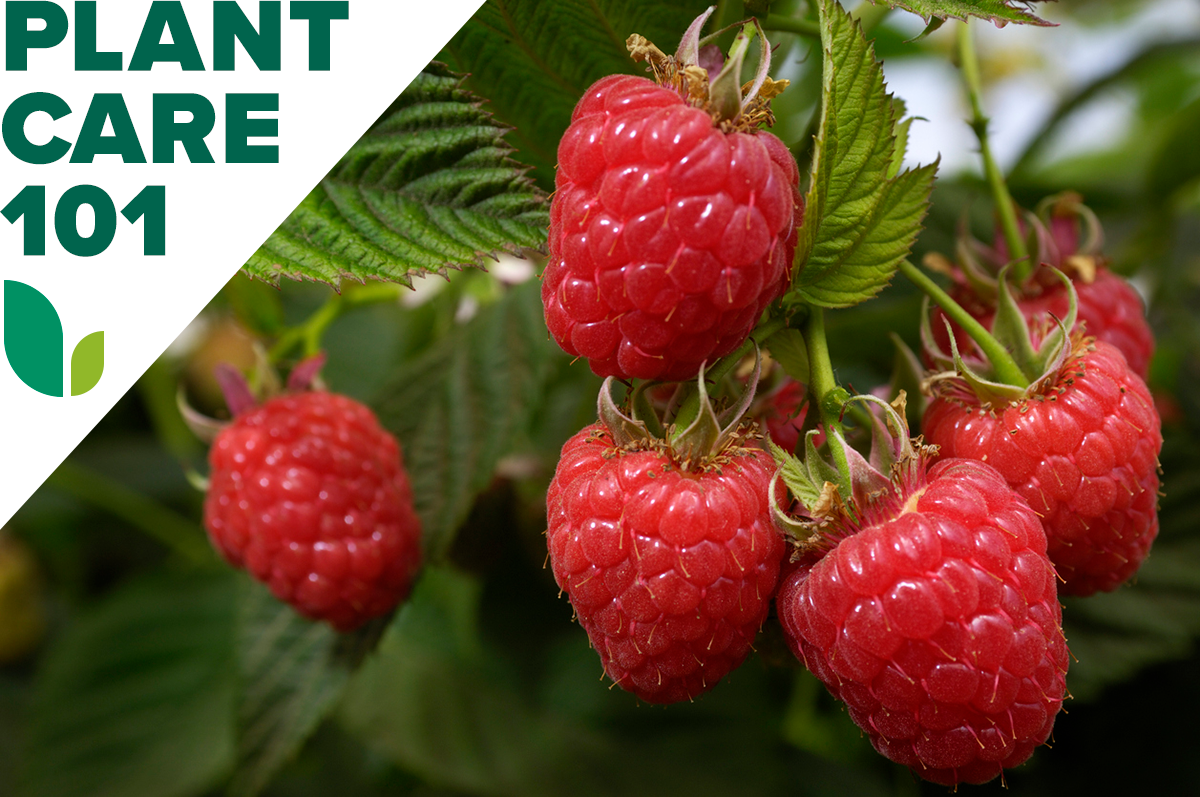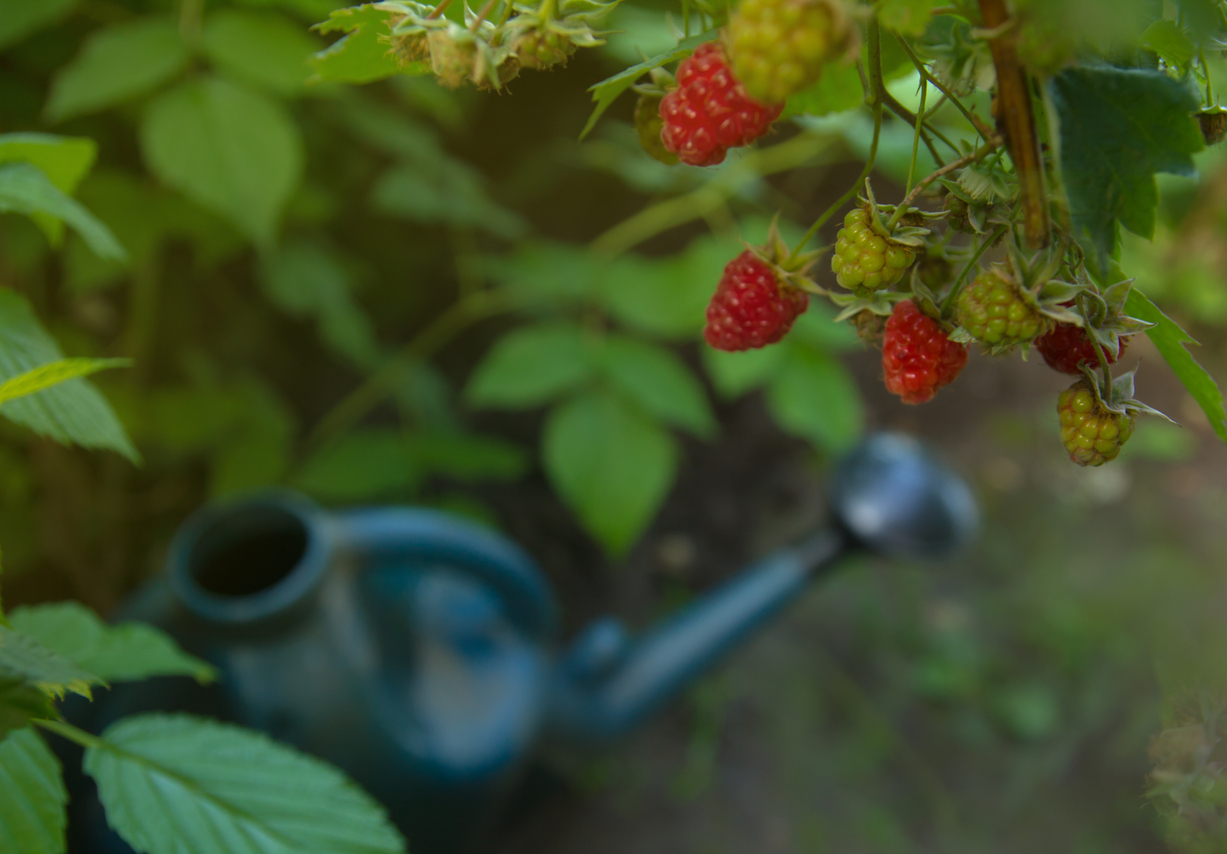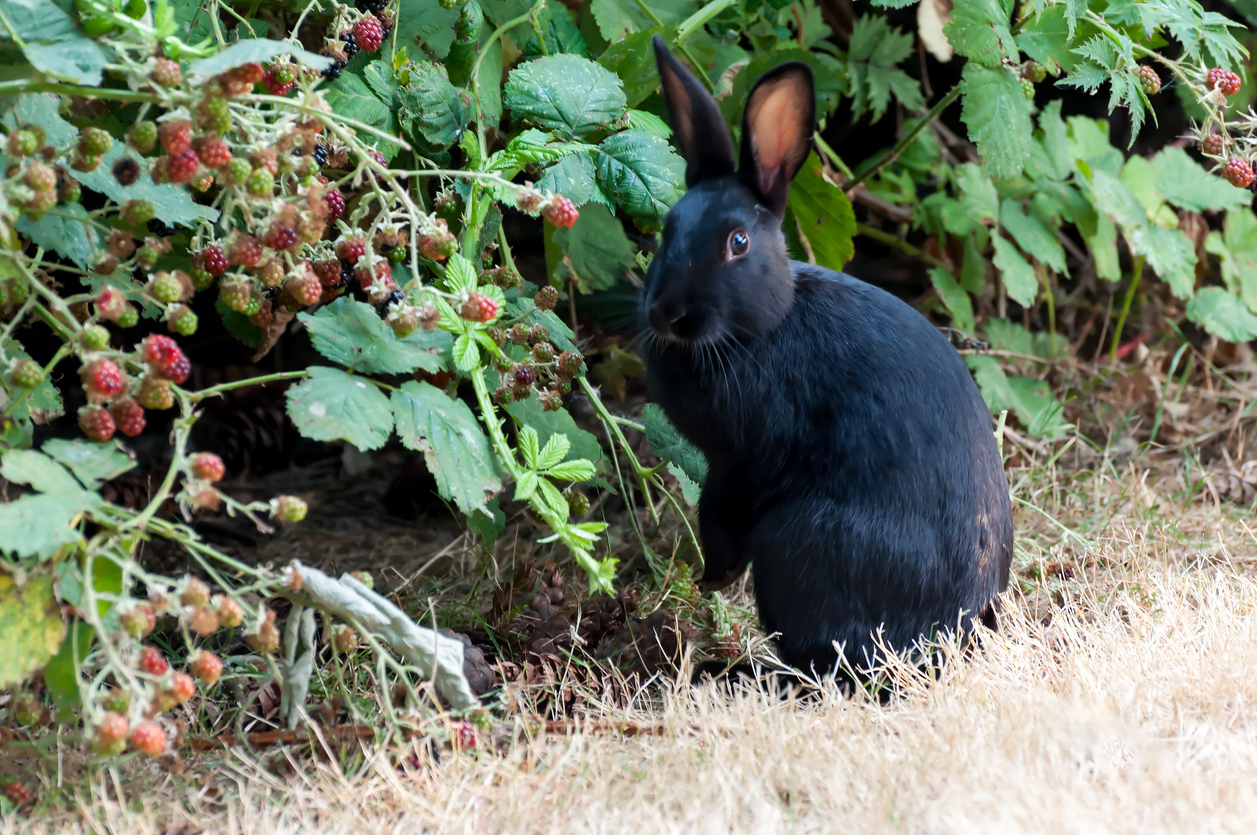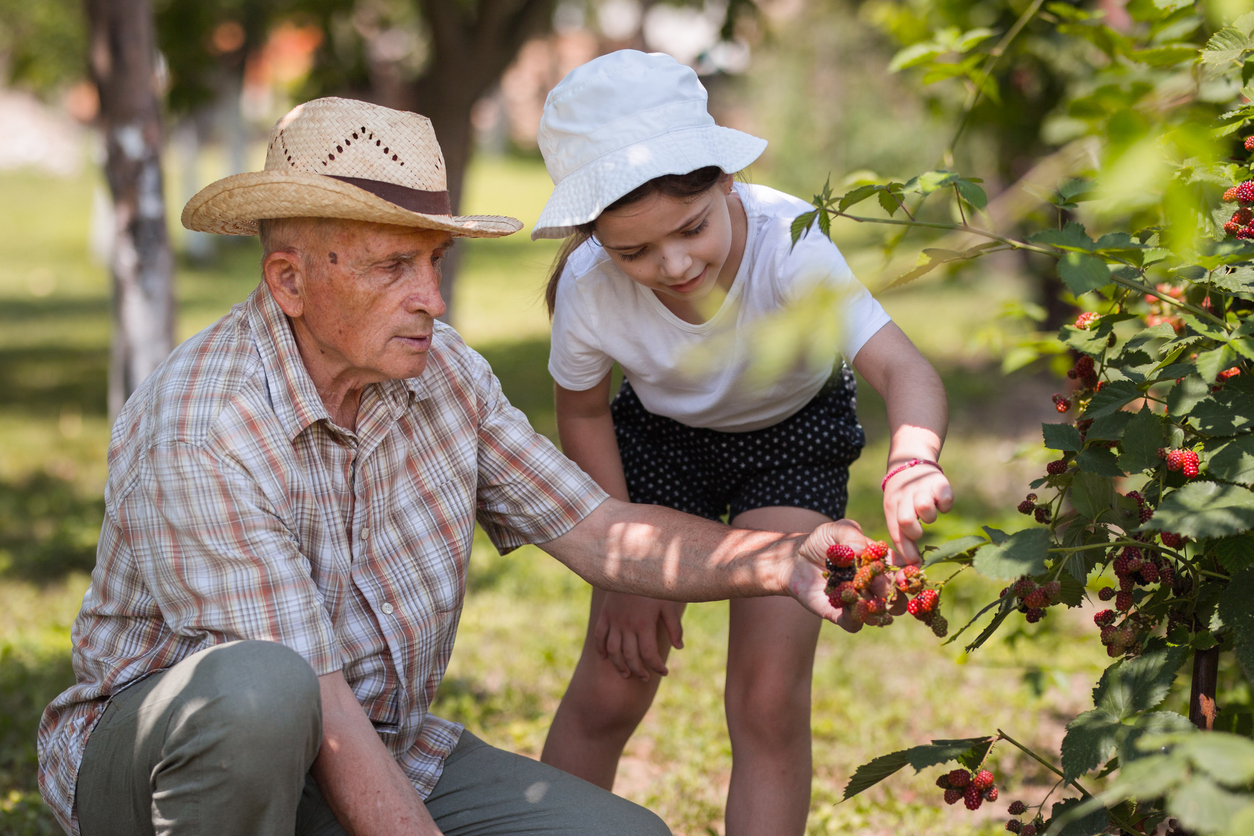

We may earn revenue from the products available on this page and participate in affiliate programs. Learn More ›
Packed with vitamins and flavor, raspberries are growing in popularity in home and restaurant dishes. Since lusciously soft raspberries are more difficult to ship than firmer berries, you’ll pay a high price for them in the supermarket. Alternatively, you can grow raspberries at home to catch them just at the peak of ripeness.
Although the berry bushes aren’t difficult to raise, directions on how to grow raspberries vary according to whether your plants are everbearing or summer-bearing cultivars. A patch of everbearing raspberries can produce for 10 to 15 years, and summer-bearing varieties for at least 5 to 10 years. Pruning isn’t strictly necessary, but it is recommended if you don’t want dead canes crowding the living ones.
RELATED: 15 Superfoods That Are Easy to Grow Yourself
Growing Raspberries at a Glance
Common Name: Raspberry
Scientific Name: Rubus idaeus, R. occidentalis
Hardiness Zone: 3 to 9
Soil: Rich, well draining, slightly acidic
Light: Full sun
Water: High
Food: Organic berry fertilizer
Propagation: Suckers or layering
Safety: Nontoxic but prickly
Raspberry Plant Characteristics
A full-grown raspberry bush can vary in height from 3 to 9 feet, and each leaf on the plant typically is made up of three to five leaflets. When do raspberries bloom? The plants’ inconspicuous four- or five-petal white flowers typically appear in late spring to early summer, and into midsummer for everbearing types.
Everbearing raspberries produce red or yellow fruits at the tips of their primocanes (green first-year canes) in autumn of their first year. If those canes are left standing over winter, they will make another crop further down on the canes during summer of the following year. At that point, the floricanes (woody second-year canes) die while the plants’ new spring-sprouting primocanes survive. They can produce autumn berries on their tips. However, some growers prefer to mow everbearing raspberries off after they fruit in autumn to force them to bear only one large (autumn) crop per year.
Summer-bearing raspberries produce either black, purple, or red berries—the color varying according to cultivar—but only during midsummer on floricanes, so they don’t fruit their first year. Therefore, their canes must be left standing over winter so that they can age from first-year nonfruiting canes to second-year fruiting ones.

Recommended Raspberry Varieties
- Anne Yellow: This everbearing raspberry produces yellow fruits rather than the typical red ones in midsummer and early autumn and grows from USDA Zone 4 to as far south as USDA Zone 9.
- Bristol: Reportedly one of the best-tasting dark varieties, this black raspberry is a summer-bearing cultivar, usually fruiting in July in USDA Zones 4 through 8.
- Heritage: The traditional red everbearing cultivar, this one crops in both midsummer and autumn in USDA Zones 4 through 8.
- Latham: Also an heirloom but a summer-bearing type, this robust variety thrives as far north as USDA Zone 3 and south to Zone 8.
Planting Raspberry Bushes
Considering when to plant raspberries depends on whether you are planting dormant, bare-root types; those already growing in pots; or raspberry seedlings you started yourself. Knowing how to plant raspberries is also important, ensuring the right soil, drainage, and sun exposure.
When is the best time to plant raspberries?
Prepare a bed the autumn before you intend to plant your raspberries by tilling composted manure into the surface of the plot. The University of Minnesota Extension suggests a rate of 3½ cubic feet of compost per 100 square feet of bed. Then set out dormant, bare-root plants as early in spring as your soil can be safely worked. Wait until after your last frost in spring to plant raspberry bushes or seedlings that already have leaves.
Where can raspberries grow?
Raspberries prefer well-draining, fertile, acidic soil with a pH between 5.6 and 6.5 and a spot in full sun. To prevent disease, avoid placing them where possibly verticillium-afflicted plants such as strawberries, potatoes, tomatoes, or maples have recently grown; the fungus can spread to the raspberry plants. If your climate is wet and your soil heavy, opt for a raised bed to prevent root rot. Position the plants near a fence or wall or provide them a trellis with guidewires on both sides of the plants.
How do you plant raspberry bushes?
When considering how to plant raspberries, keep in mind that you want them spaced widely apart to allow good air movement.
- Dig holes shallow enough so that when the plants are set in place with the holes backfilled, their crowns remain 1 to 2 inches above ground level.
- Water the plants and place 2 to 3 inches of mulch around them, keeping it off of the plants’ crowns.
- When planting raspberries, space everbearing types 2 to 3 feet apart and summer-bearing types 3 to 4 feet apart—in rows 8 to 10 feet apart—cutting the canes back to 6 inches.
Can you grow raspberries in containers?
Although raspberries will grow in containers, they require large ones. Each pot should be at least 2 feet deep and hold 20 to 30 gallons of potting mix. For that mix, Oregon State University Extension suggests two parts of garden or potting soil, one part perlite or pumice, and one part finely ground bark. Such a container will hold one summer-bearing raspberry with four to five canes or one everbearing type with five to eight canes.
RELATED: How To: Plant a Food Forest for Foraging at Home

Watering Raspberries
When you are caring for raspberries, make sure that they receive at least 1 inch of water per week, with 1½ inches being even better. If your climate doesn’t provide that much via rainfall, you may need to use drip irrigation or hand watering. Although the soil around the bushes shouldn’t be soggy, it never should be allowed to dry out completely either. A layer of mulch—such as grass clippings or shredded leaves—atop the soil should help preserve its dampness.
Fertilizing Raspberry Plants
Growing raspberries need to eat just as growing children do, and they have big appetites! In addition to adding in the compost already mentioned, incorporate an organic berry fertilizer such as 4-3-4 into the soil when you prepare the bed, adding about 10 pounds of the fertilizer per 100 square feet of ground. In subsequent years, use 5 pounds per 100 square feet applied once in early spring and again a couple months later. Most berry fertilizers contain sulfur to help keep the ground acidic.
Pruning Raspberries
If you want only one autumn crop per year from everbearing raspberries, mow them off or cut them back to the ground in late autumn. Should you prefer a midsummer crop too, leave the canes standing over winter.
Once summer-bearing raspberries finish fruiting, cut back to the ground the floricanes that produced berries that year, but leave the new primocanes standing over winter. In spring, prune the side branches of those canes back to 12 to 18 inches. When new primocanes sprout and have reached 2 to 3 feet in height, snip off their tips to force them to branch.
Propagating Raspberry Bushes
Everbearing raspberries produce suckers that shoot up beside the mother plant. Use a garden spade to slice those off, making sure that you retrain some roots on each sucker, and replant them.
The canes of summer raspberries arch out from the center of the plant and often will root naturally wherever the tips of those canes touch the ground. You can take advantage of that raspberry plant feature by pinning down a few of those tips and covering them with 2 inches or so of soil. The following spring, you should be able to cut the new plants away from their parents.
Safety Considerations
Both raspberries and their foliage are edible, and the leaves often are used to make tea. As with more common teas, the leaves contain tannins, which may be irritating to some digestive systems. Also, avoid feeding your dog large amounts of raspberries since they contain xylitol, which potentially could cause liver disease or hypoglycemia in your pet.
The chief danger of raspberries is, of course, their thorns. To avoid scratches, purchase thornless types of raspberries or wear thorn-resistant fabrics such as heavy denim or canvas when picking the berries, covering as much of your skin as possible.
RELATED: What Is Companion Planting and How to Use It in Your Home Garden

Potential Pests and Diseases
Wild rabbits are one of the chief enemies of raspberries since they will eat the plants back to the ground during winter, possibly preventing any harvest the following summer. Therefore, you may want to consider placing a chicken-wire fence around your berry patch. Alternatively, opt for everbearing raspberries, which can produce a crop the following autumn even after being cut back in winter.
If your bushes appear to be stunted and have mottled leaves or crumbly fruit, check online information on viruses such as tomato ringspot virus—which isn’t confined just to tomatoes—and raspberry leaf curl virus.
Harvesting Raspberries
Because birds also love berries, you may need to cover your bushes with netting once the fruits begin ripening if you don’t want to share.
When is the best time to harvest raspberries?
Harvest your berries when they are the color they are supposed to be upon ripening and when they slip easily off their cores rather than needing a tug to break free. The fruit color also should have lost a bit of its gloss and be turning to a more matte shade.
How do you harvest raspberries?
Raspberry harvesting should be done berry carefully! Follow these steps on how to harvest raspberries for delicious results:
- Because raspberries are soft, use shallow containers when harvesting them to avoid crushing them under the weight of other berries, piling them no more than three deep.
- Pick the fruits on a dry day and avoid washing them until you intend to eat them since wet berries spoil more quickly.
- Harvest your berries at least once every 3 days to prevent the fruit from rotting.

How do you store raspberries?
Store the raspberries in your refrigerator, where the temperature shouldn’t be higher than 41 degrees Fahrenheit, in a covered container that has ventilation holes. That could be a clamshell plastic produce container—such as those in which berries are sold at the supermarket—or a berry basket topped with plastic wrap. Use the berries within 2 days.
Preparing Raspberry Plants for Winter
Planting raspberries beside a wall or fence and mulching the plants should provide them some protection. However, if you live in a zone where the canes tend to die back completely over winter, you may want to try covering them during the cold season.
To do that, bend them down to the ground, holding them in place with soil piled on their tips. Then dig a shallow trench beside the canes, tossing the soil from it atop them until they are lightly covered. In spring, shake the soil off the canes and return it to the trench.
Looking for more produce-producing plants? Check out our guides on growing broccoli, carrots, and sweet potatoes.
